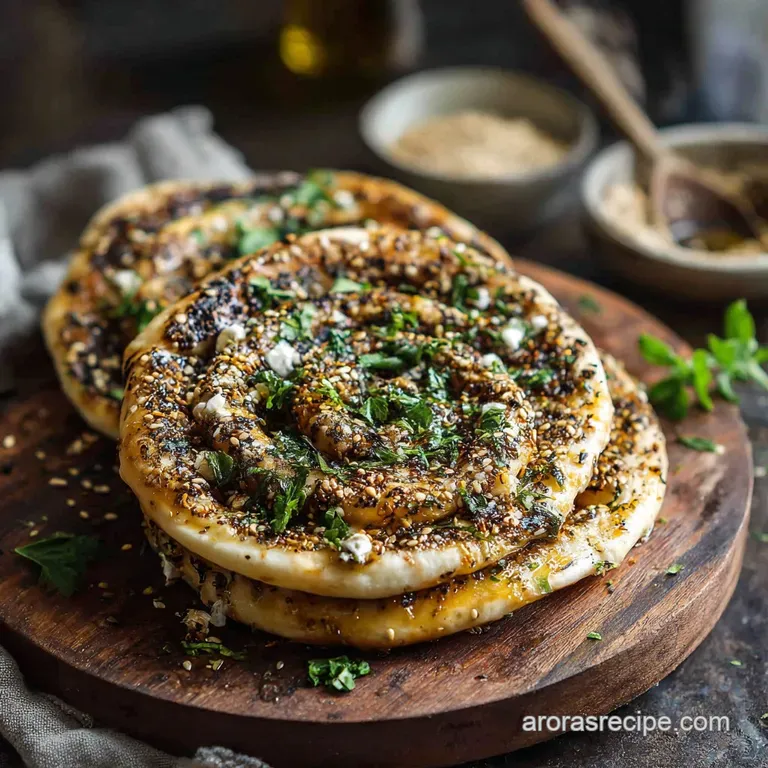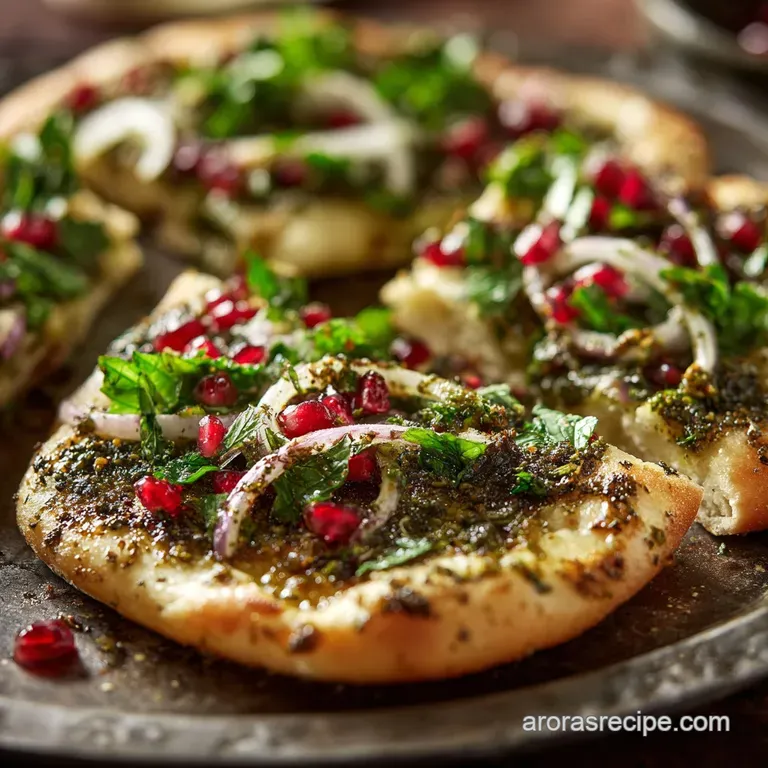Manakish Zaatar: Authentic Middle Eastern Comfort Flatbread Recipe

Table of Contents
- The Definitive Guide to Authentic Manakish Zaatar
- Achieving the Perfect Texture: Why This Manakish Recipe Works
- Essential Ingredients for the Best Homemade Manakish Zaatar
- Step-by-Step: Making Authentic Manakish Dough and Topping
- Assembling and Baking Your Manakish Zaatar (The Oven Method)
- Mastering the Bake: Expert Tips and Common Manakish Mistakes
- Storing, Freezing, and Reheating Manakish Zaatar
- Traditional Pairings: What to Serve With Your Flatbread
- Recipe FAQs
- 📝 Recipe Card
The Definitive Guide to Authentic Manakish Zaatar
Close your eyes for a second and imagine the scent of toasted sesame, earthy thyme, and vibrant sumac, all warmed by rich olive oil. That, my friend, is the essence of Manakish Zaatar fresh from the oven, puffy at the edges and glistening in the center.
It’s one of those smells that instantly transports you to a bustling Levantine bakery, even if you’re just standing in your mismatched kitchen.
This flatbread is absolute comfort food, the kind of breakfast or quick snack that requires minimal effort but delivers maximum flavor payoff. Seriously, we are talking about a few basic pantry ingredients transformed into something extraordinary in less than two hours, most of which is just inactive proofing time.
It’s cheap, it's fast, and it stops me from ordering sad, stale bagels on Sunday mornings.
Forget those dry, cardboard versions you sometimes find. We are aiming for a beautiful, soft dough that's chewy yet tender, perfectly balanced by that incredible, tangy Za’atar spread.
Grab your apron because we’re making the real deal Authentic Manakish Zaatar, and I promise you, this Middle Eastern flatbread recipe will become a permanent fixture in your rotation.
Achieving the Perfect Texture: Why This Manakish Recipe Works
What is Manakish? Beyond the Flatbread Label
Manakish (sometimes called Manakeesh) isn't just a flatbread; it’s a canvas for flavor, traditionally served hot from a stone oven called a furn . Think of it as the Middle East’s answer to pizza, but usually simpler, cleaner, and far more adaptable.
This isn't just bread with topping; it’s a fundamental part of the culture, enjoyed everywhere from street carts to formal family gatherings.
The History and Cultural Significance of Za’atar
Za’atar is not just a spice; it’s a way of life, and the word often refers both to the spice blend and the herb (wild thyme). The specific blend we use dried thyme, sumac, toasted sesame seeds, and salt is iconic, dating back generations.
Families often have their own secret Za'atar recipe, but the core flavor is always earthy, nutty, and distinctly tart. That powerful flavor profile is what makes this the best manakish zaatar bread.
Why This Levantine Staple Deserves Your Kitchen
Look, making bread from scratch sounds daunting, but this dough recipe is surprisingly forgiving. It requires minimal kneading compared to, say, sourdough, and the over high heat bake is so fast it barely messes up your kitchen.
Plus, the sheer joy of pulling a blistered, fragrant manakish zaatar out of your oven is completely unmatched. You’ll feel like a culinary hero, trust me.
The Role of Proofing Time in an Airy Dough
When making the manakish zaatar dough recipe, patience during the proofing stage is non-negotiable. Giving the dough 60 to 90 minutes to rise slowly allows the gluten network to relax and the yeast to produce those lovely air pockets.
This extended rest is what ensures the final product is light and chewy, not dense and flat. If you rush it, your flatbread will taste heavy, which is just sad.
Balancing Acidity: The Sumac Olive Oil Blend
This is the secret weapon: the topping isn't just dry spice mixed with oil. high-quality Za’atar contains tangy sumac, which provides an intense, lemony flavor. When you fully saturate the blend with good extra virgin olive oil, that acidity mellows out perfectly during the bake.
The oil prevents the thyme from burning and creates a luscious, slightly molten topping that clings perfectly to the dough.
Baking Hot and Fast for the Crisp Edge
Manakish Zaatar absolutely demands a over high heat environment. If your oven is too cool, the dough takes too long to cook, resulting in a dry texture and sad, pale edges. We need that blast of heat (450°F minimum, 500°F if you can swing it!) to give the bread a soft, airy middle and a signature, slightly blistered crust in minutes.
High heat is the difference between bread and an Authentic Manakish Zaatar.
Essential Ingredients for the Best Homemade Manakish Zaatar
Demystifying the Za’atar Blend: Quality Over Quantity
Please, please, please, do not skimp on your Za’atar. It is literally half the recipe! A cheap blend will taste overwhelmingly of dried sawdust and salt. Look for vibrant color and clearly visible sesame seeds and sumac powder.
If you can, buy it from a reputable Middle Eastern grocer; the difference in flavor is monumental.
Choosing the Right Flour for Maximum Chew
I am a huge believer in using bread flour for this Middle Eastern flatbread recipe if you can find it. It has a higher protein content, which develops stronger gluten when kneaded. That strength gives your manakish zaatar that lovely, satisfying chewiness we all crave.
All-purpose flour is fine, but bread flour is better.
Olive Oil Quality Matters: Culinary Selection Notes
We use olive oil twice: a little bit in the dough for softness and a lot in the topping. The olive oil in the topping is essentially the sauce, so its flavor shines through. Use your best extra virgin olive oil for the Za’atar spread. You’ll taste the difference.
Yeast Types and Activation Guide
I prefer Active Dry Yeast because that little foamy proofing step gives me confidence that my dough is going to rise. If you use Instant Yeast, you can just dump it straight in with the dry ingredients, which is faster. Just make sure your packet isn't expired!
Expired yeast is the number one cause of flat manakish dough.
Decoding Dried Thyme, Sesame, and Sumac Ratios
If you are mixing your own blend, the general ratio is heavy on the thyme, followed by sesame seeds, and then a slightly smaller amount of sumac for tang. The total quantity should be about 50% spice blend to 50% olive oil when mixing the topping. It should resemble a slightly thick, wet paste.
Ingredient Substitutions Q&A (Yeast, Oil, & Flour)
Need to swap something out? Don't panic. We can usually make it work with what you have.
| Original Ingredient | Acceptable Substitute | Notes |
|---|---|---|
| Bread Flour | All-Purpose (Plain) Flour | Results in a slightly softer crumb, less chew. Increase kneading time by 1 minute. |
| Active Dry Yeast | Instant/Rapid Rise Yeast | Use the same amount but mix it directly into the dry flour/salt mixture. Skip the warm water activation step. |
| Olive Oil (Dough) | Canola or Vegetable Oil | For the dough only; use EVOO for the Za’atar topping for flavor. |
| store-bought Za’atar | Homemade Blend | Mix dried thyme, toasted sesame seeds, ground sumac, and salt. |
step-by-step: Making Authentic Manakish Dough and Topping

Kneading Techniques for a Smooth, Elastic Flatbread
If you are using a stand mixer, medium speed for 6 minutes is perfect for developing gluten. If you are kneading by hand, use the heel of your palm and push the dough away, rotating it frequently.
You are done when the dough ball is smooth and springs back slowly when poked; it shouldn't look raggedy anymore.
The Optimal Dough Resting and Dividing Process
Warmth is key for the first rise, but don't place the dough directly on a radiator unless you want it to ferment too quickly and taste boozy. Ninety minutes in a slightly warm spot is ideal. Once doubled, punch it down gently don't kill it! Divide the dough equally into 8 balls.
Weighing them is the best way to ensure even baking time.
Chef's Note: After dividing, let the balls rest for 10 minutes before rolling. This bench rest relaxes the gluten completely, meaning when you roll them thin, they won't snap back into thick little pucks.
Preparing the Potent Za'atar Oil Spread
This is almost too simple. Just combine the Za’atar, the ½ cup of high-quality EVOO, and a pinch of salt. Mix it thoroughly. It should be easily spreadable but not watery. If it looks too dry, add a tiny bit more oil until it resembles a thick, glistening sludge.
Assembling and Baking Your Manakish Zaatar (The Oven Method)
Shaping the Rounds and Creating the Topping Wells
Roll your dough balls into 6 7 inch circles, aiming for thinness. Remember, they will puff up! The flatter they are now, the better the final texture will be. Place them on parchment paper or lightly oiled baking sheets.
Now, spread 2 3 tablespoons of the prepared za'atar mixture right up to the edge, leaving maybe a half inch border. Don't press too hard.
Achieving the High Heat: Oven Setup and Baking Surface
Preheat that oven to the highest setting, 450°F (230°C) or higher. If you have a pizza stone or baking steel, place it on the middle rack while the oven preheats for at least 30 minutes. This preheated surface delivers the essential bottom heat necessary for that classic crisp chewy texture.
How to Load and Monitor the Baking Process
If using a stone, slide the manakish (parchment and all, if possible) directly onto the stone. If you're using baking sheets, just load them in. Bake for 5 to 8 minutes. You'll know they are done when the edges are visibly puffed up, golden brown, and the za'atar oil is bubbling slightly.
They cook fast !
Mastering the Bake: Expert Tips and Common Manakish Mistakes
Common Mistakes
- Under Oiling the Topping: If your Za’atar spread looks crumbly or too dry, it will turn powdery and bitter in the oven. Fix: Add more high-quality EVOO until it's a thick, wet paste. It should look like it's swimming in oil, not coated in it.
- Rolling the Dough Too Thick: A thick dough yields a heavy, dry bread. Fix: Roll the dough until it feels almost too thin, about 1/8th inch thick. The high heat will guarantee the lift we want.
- Baking Too Cool: Low temperature (under 400°F) produces sad, hard Manakish. Fix: Crank up the heat! Use the hottest oven setting you can safely manage, and always preheat your baking surface thoroughly.
Storing, Freezing, and Reheating Manakish Zaatar
Best Practices for Short Term Storage
Manakish is best eaten immediately, but leftovers are inevitable sometimes. Store fully baked Manakish in an airtight container at room temperature for up to 2 days, or in the fridge for 3 days. They lose their crispness quickly, so wrap them tightly.
Freezing Unbaked Dough vs. Cooked Flatbreads
You can totally freeze Manakish!
- Cooked: Cool completely, stack separated by parchment squares, and wrap tightly in foil/plastic. Freeze for up to 3 months.
- Unbaked Dough: Divide and ball the dough, then freeze the individual balls. Thaw overnight in the fridge before rolling and topping.
Reviving Day-Old Manakish to its Crispy Best
Do NOT microwave them; they turn rubbery. The key is high, dry heat. Place the cold Manakish directly on a baking sheet in a 350°F (175°C) oven for about 5 minutes, or use a toaster oven. They will crisp right up and the za'atar flavor will bloom again.
Traditional Pairings: What to Serve With Your Flatbread
Manakish Zaatar is often the star of the show, but it plays incredibly well with other fresh, tangy elements. This makes creating a Lebanese breakfast spread super easy!
Essential Accompaniments: Tomatoes, Mint, and Labneh
The tangy, rich flavor of the Manakish needs fresh counterpoints. I always serve mine with:
- Labneh: Strained yogurt, thick and tangy, perfect for scooping up any excess oil.
- Fresh Vegetables: Sliced cucumbers and ripe tomatoes, maybe even a little fresh mint sprinkled on top.
- Olives: Salty Kalamata or cured green olives provide necessary brine.
Creating a Lebanese Breakfast Spread (Mezze)
To make a full mezze spread, add some hummus, feta or akkawi cheese cubes, and some extra fresh pita bread for scooping. It’s colorful, flavorful, and incredibly satisfying. Honestly, who needs waffles when you have this?
Beverages that Complement the Tangy Za’atar Flavor
The best drink to cut through the richness of the olive oil and complement the sumac’s tang is hot, black tea, often sweetened slightly and traditionally flavored with fresh mint leaves. Or, if you prefer coffee, strong Arabic coffee is the perfect robust partner.

Recipe FAQs
Why is my Manakish dough tough or not rising properly?
This usually indicates the dough was over kneaded or the yeast was inactive, often because the water was too hot or too cold. Ensure your liquid temperature is around 105-115°F (40-46°C) and allow sufficient time for the first rise, ideally in a warm, draft free spot.
If the dough feels stiff after baking, try adding a little more olive oil to the initial mix next time for tenderness.
My Za'atar topping looks dry or crumbly after baking. What went wrong?
The topping requires enough olive oil to create a cohesive paste that stays moist during the high heat of baking. If the mixture is too dry initially, the thyme will burn; ensure the ratio is approximately 1 part oil to 2 parts Za'atar mixture before spreading it thinly on the dough.
Alternatively, your oven might be too cool, leading to longer baking times and subsequent drying out of the topping.
Can I use whole wheat flour to make a healthier Manakish dough?
Absolutely, you can substitute up to 50% of the all-purpose flour with whole wheat flour for added fiber and a nuttier flavor. Keep in mind that whole wheat absorbs moisture differently, so you may need to add a few extra tablespoons of water during the kneading process.
The resulting dough will be slightly denser than the traditional white flour version.
Is it acceptable to add cheese to the Za'atar Manakish?
While traditionally Za'atar Manakish is plain, combining it with cheese (often called Manakish Jibneh wa Za'atar) is incredibly popular and delicious. Use a soft, salty white cheese like Akawi, Nabulsi, or a mixture of mozzarella and feta, placing it underneath the Za'atar paste before baking.
This addition provides a wonderful creamy richness to the tangy topping.
What is the best way to store leftover Manakish, and can I freeze it?
Store cooled leftovers wrapped tightly in foil or an airtight container at room temperature for up to 2 days, or refrigerate for up to 4 days. Manakish freezes exceptionally well; wrap individual pieces in plastic wrap, place them in a freezer bag, and reheat them straight from frozen.
Reheat in a 350°F (175°C) oven until the edges are crisp.
What should I do if I don't have good quality, authentic Za'atar?
If high-quality imported Za'atar is unavailable, you can create a decent temporary blend using dried thyme, toasted sesame seeds, and a good pinch of ground sumac for the necessary tang. The final flavor profile relies heavily on the quality of the sumac and the oil, so ensure those components are fresh.
Always store your spice blend in an airtight container away from direct sunlight.
Can I use store-bought pizza dough or pita bread dough for this recipe?
Yes, using pre-made dough significantly cuts down on prep time and works perfectly well for a quick preparation. However, authentic Manakish dough is slightly richer and softer due to added oil and longer proofing times than typical pizza dough.
If using store-bought dough, allow it to rest for 30 minutes after shaping and before topping to achieve maximum softness and airiness.
Manakish Zaatar Authentic Lebanese Thyme Flatbre

Ingredients:
Instructions:
Nutrition Facts:
| Calories | 853 kcal |
|---|---|
| Protein | 13.6 g |
| Fat | 42.2 g |
| Carbs | 108.8 g |